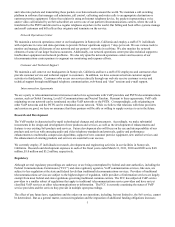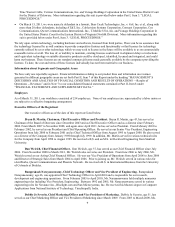8x8 2011 Annual Report Download - page 19
Download and view the complete annual report
Please find page 19 of the 2011 8x8 annual report below. You can navigate through the pages in the report by either clicking on the pages listed below, or by using the keyword search tool below to find specific information within the annual report.17
• The difficulty of assimilating the operations and personnel of the combined companies;
• The risk that we may not be able to integrate the acquired services or technologies with our current services, products,
and technologies;
• The potential disruption of our ongoing business;
• The diversion of management attention from our existing business;
• The inability of management to maximize our financial and strategic position through the successful integration of the
acquired businesses;
• Difficulty in maintaining controls, procedures, and policies;
• The impairment of relationships with employees, suppliers, and customers as a result of any integration;
• The loss of an acquired base of customers and accompanying revenue;
• The assumption of leased facilities, other long-term commitments or liabilities that could have a material adverse impact
on our profitability and cash flow; and
• The dilution to our existing stockholders from the issuance of additional shares of common stock or reduction of
earnings per outstanding share in connection with an acquisition that fails to increase the value of our company.
As a result of these potential problems and risks, businesses that we may acquire or invest in may not produce the revenue,
earnings, or business synergies that we anticipated. In addition, there can be no assurance that any potential transaction will be
successfully identified and completed or that, if completed, the acquired business or investment will generate sufficient revenue
to offset the associated costs or other potential harmful effects on our business.
Increased taxes on our service will increase our customers' cost of using our service and/or reduce our profit margins
(to the extent the costs are not passed through to our customers) and we may be subject to liabilities for past sales and
additional taxes, surcharges and fees.
Until 2007, we did not collect or remit state or municipal taxes, such as sales, excise, and ad valorem taxes, fees or surcharges
on the charges to our customers for our services, except that we have historically complied with the collection of California
sales tax and financial contributions to the 9-1-1 system and the federal Universal Service Fund. We have received inquiries or
demands from a number of state and municipal taxing agencies seeking payment of taxes, fees or surcharges that are applied to
or collected from customers of providers of traditional public switched telephone network services. Although we have
consistently maintained that these taxes, fees or surcharges do not apply to our service for a variety of reasons depending on the
statute or rule that establishes such obligations, a number of states have changed their statutes as part of streamlined sales tax
initiatives and we are now collecting and remitting sales taxes in those states. The collection of these taxes, fees or surcharges
will have the effect of decreasing any price advantage we may have over other providers who have historically paid these taxes
and fees. Our compliance with these tax initiatives will also make us less competitive with those competitors who choose not to
comply with these tax initiatives. Three states currently are conducting sales tax audits of our records. In October 2009 and in
August 2010, we received notices of proposed assessment as a result of two of the sales tax audits amounting to approximately
$1.6 million and $0.4 million, respectively, which we consider to be unsubstantiated. As of March 31, 2011, there has been no
change in the status of these assessments.Wecollectandhaveaccruedfortaxesthatwebelievearerequiredtobe
remitted.Whilehistorically,theamountsthathavebeenremittedhavebeenwithinestablishedaccrualsif our ultimate
liability exceeds the accrued amount, it could result in significant charges to our earnings.
Our emergency and E-911 calling services are different from those offered by traditional wireline telephone companies
and may expose us to significant liability. There may be risks associated with limitations associated with E-911
emergency dialing with the 8x8 service.
Both our emergency calling service and our E-911 calling service are different, in significant respects, from the emergency
calling services offered by traditional wireline telephone companies. In each case, the differences may cause significant delays,
or even failures, in callers' receipt of the emergency assistance they need.
We are offering E-911 service that is similar to the emergency calling services provided to customers of traditional wireline
telephone companies in the same area. For those customers located in an E-911 area, emergency calls are routed directly to an
emergency services dispatcher at the PSAP in the area of the customer's registered location. The dispatcher will have automatic
access to the customer's telephone number and registered location information. If a customer moves their 8x8 service to a new
location, the customer's registered location information must be updated and verified by the customer. Until that takes place,
the customer will have to verbally advise the emergency dispatcher of his or her actual location at the time of an emergency 9-
1-1 call. This can lead to delays in the delivery of emergency services.
























